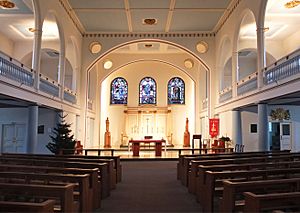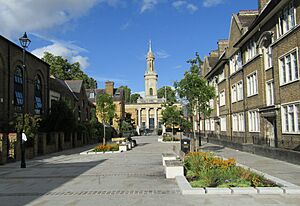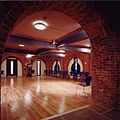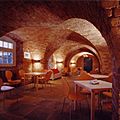St Peter's Church, Walworth facts for kids
Quick facts for kids St. Peter's Church |
|
|---|---|

St Peter's Nave & Chancel
|
|
| Location | Southwark, London |
| Country | United Kingdom |
| Denomination | Church of England |
| Churchmanship | Liberal Anglo-Catholic |
| Website | www.stpeterswalworth.org |
| Architecture | |
| Architect(s) | John Soane HMDW Architects |
| Years built | 1823–1825 |
| Administration | |
| Diocese | Anglican Diocese of Southwark |
St Peter's Church is a welcoming Anglican church in Walworth, London. It was built a long time ago, between 1823 and 1825. This church was the very first one designed by the famous architect Sir John Soane. St Peter's is special because it is the best-preserved of all the churches Soane designed. It is a lively parish church that serves its local community.
Contents
History of St Peter's Church
Building the Church
St Peter's Church was built after the Napoleonic wars. The government helped pay for new churches then. St Peter's received a grant from the Church Building Commission. The total cost to build the church was about £18,592. The grant covered about half of this cost. Today, St Peter's is a Grade I listed building, which means it is very important and protected.
Church Design and Features
Sir John Soane designed St Peter's Church. It looks similar to other churches he designed, like Holy Trinity Church Marylebone. He used special London bricks and stone for the outside. A key feature of Soane's design is the tall, arched windows set into deep walls. The front of the church has a unique style with columns and a decorative top.
Changes Over Time
The church has been updated several times. The east end was changed in 1888. After being damaged during World War II, a big repair project happened in 1953. The inside of the church was also rearranged in 1982. St Peter's has always had a strong tradition of worship and caring for its community.
St Peter's During World War II
During WW2, the church's crypt (an underground room) was used as a safe place. Many people, sometimes hundreds, would shelter there every night during air raids. On October 29, 1940, the church was badly hit by bombs. Sadly, many people sheltering in the crypt were killed or injured. The church was repaired and reopened in 1953.
Organs and Bells
The church has a large organ built in 1949. It was moved to St Peter's in 2009. Before that, the church had an older organ from 1824. This older organ survived the bombing and was repaired. St Peter's also has a set of eight bells. They were all made in 1971.
The Churchyard Garden
The churchyard, which was once used for burials, was closed in 1853. In 1895, a kind church leader named Canon John Horsley helped turn it into a public garden. The Goldsmiths' Company paid for the work. Now, it is a lovely green space with grass and seats for everyone to enjoy.
St Peter's Church Today
Today, St Peter's is a busy and friendly Anglican church. It serves the people of East Walworth. The church works closely with St Peter's CofE Primary School and nursery. The church's leader is even the head of the school's governors. A joyful Sunday service, called the Parish Mass, takes place every week at 10:30 AM.
In 2022, the street in front of the church, Liverpool Grove, was made into a pedestrian-only area. This means cars cannot drive there, making it safer and nicer for people.
Restoration Projects
Crypt Redevelopment
The crypt of St Peter's Church has been recently updated. It is now home to Trampoline CIC, which is a group that helps people start their own businesses in the community. The crypt also hosts Saint Louie Bakery and Cafe. This cafe also manages the hiring of the church hall and a meeting room. These spaces can be used for many things, like performances, parties, and workshops. HMDW Architects designed this project.
Main Worship Area Updates
The main part of the church, where services are held, has also been restored. This work included fixing the reredos (a decorated screen behind the altar). A new lighting system was also put in place.
Gallery
See also





